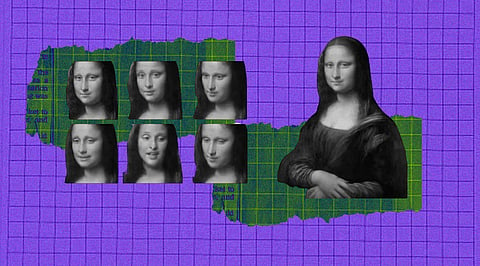

Monalisa, the classic painting by Leonardo Da Vinci, looks like smiling back at the onlookers and it is bewitching in a way. A few years ago, a deep fake video brought Mona Lisa to life to the amazement of common people. Perhaps you might have had a few lunatic thoughts of possessing her. If so, you are almost there. New research revealed by Samsung AI center, Moscow, released one-shot 'neural head avatar technology'. It is the new version of the deepfake technology which doesn't require a similar input picture for the expected output. You can be a vague tik-tok star not even remotely resembling Monalisa but can generate a troll video on Monalisa by being Monalisa. Sounds interesting!!
As per the paper published by the team, the megapixel resolution is achieved by advancing the neural head avatar technology, an algorithm that to date was stumbling around cross-driving synthesis – a process in which the driving image can be starkly different from the animated source image. The new neural architecture developed by the team is capable of generating a high-resolution neural avatar model, in its student version runs in real-time and has the identity locking capability – a potential solution to check scammers adept at exploiting the technology. The team stated, "We propose a set of new neural architectures and training methods that can leverage both medium-resolution video data and high-resolution image data to achieve the desired levels of rendered image quality and generalization to novel views and motion," in their abstract. However, the authors acknowledge that the method underperforms in the region of shoulders and clothing and said the issues will be looked into.
Deepfakes, in the earlier models, would depend on producing realistic images through neural head avatars, bypassing the complexity of realistic physics-based modeling of human avatars by training themselves on the appearance directly from the source videos. Over the years, this model has been improved largely to take a single (one-shot) image as input. Using generic knowledge about the human appearance, the neural head model would create the avatars, though lacking good image quality. It is due to lower image resolution seeping in from a large-scale data set – a near impossible hurdle to overcome. For the one-shot neural model, they used architecture to combine the 3D volume of the images with latent motion representations. In addition, the novel contrastive loss adopted for this model uses novel contrastive loss that allows higher degrees of disentanglement between the latent motion and appearance representations.
So, what makes it scary? The futurism reports, even though the student version of the deep fake technology comes with a user ID feature, the main model is still vulnerable to bounty hunters — be it online trolls, or gold diggers, it would become a wild wild west for impersonators. Now that these deepfake algorithms will generate par realistic images, it's possible that Monalisa can be included in the esoteric frame of your choice. All credits to the SamsungAI research team.
Join our WhatsApp Channel to get the latest news, exclusives and videos on WhatsApp
_____________
Disclaimer: Analytics Insight does not provide financial advice or guidance. Also note that the cryptocurrencies mentioned/listed on the website could potentially be scams, i.e. designed to induce you to invest financial resources that may be lost forever and not be recoverable once investments are made. You are responsible for conducting your own research (DYOR) before making any investments. Read more here.
